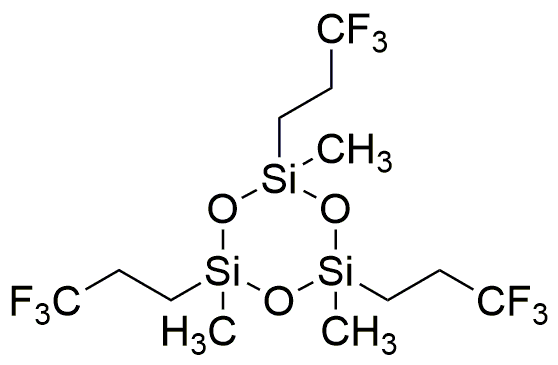1,3,5-Tris(3,3,3-trifluoropropyl)-1,3,5-trimethylcyclotrisiloxane is widely utilized in research focused on:
- Coatings and Sealants: This compound is used to create durable, water-repellent coatings for various surfaces, enhancing protection against moisture and chemicals in industries like construction and automotive.
- Textile Treatments: It serves as a finishing agent for textiles, providing water and stain resistance, which is particularly beneficial in the fashion and upholstery sectors.
- Electronics: In the electronics industry, it is applied in the manufacturing of insulating materials, contributing to improved thermal stability and electrical performance in devices.
- Cosmetics: The compound is incorporated into cosmetic formulations for its silicone properties, offering a smooth application and a soft feel on the skin, making it popular in skincare and makeup products.
- Lubricants: It is used in specialty lubricants, providing excellent thermal stability and reducing friction in high-performance machinery, which is crucial in automotive and industrial applications.
General Information
Properties
Safety and Regulations
Applications
1,3,5-Tris(3,3,3-trifluoropropyl)-1,3,5-trimethylcyclotrisiloxane is widely utilized in research focused on:
- Coatings and Sealants: This compound is used to create durable, water-repellent coatings for various surfaces, enhancing protection against moisture and chemicals in industries like construction and automotive.
- Textile Treatments: It serves as a finishing agent for textiles, providing water and stain resistance, which is particularly beneficial in the fashion and upholstery sectors.
- Electronics: In the electronics industry, it is applied in the manufacturing of insulating materials, contributing to improved thermal stability and electrical performance in devices.
- Cosmetics: The compound is incorporated into cosmetic formulations for its silicone properties, offering a smooth application and a soft feel on the skin, making it popular in skincare and makeup products.
- Lubricants: It is used in specialty lubricants, providing excellent thermal stability and reducing friction in high-performance machinery, which is crucial in automotive and industrial applications.
Documents
Safety Data Sheets (SDS)
The SDS provides comprehensive safety information on handling, storage, and disposal of the product.
Product Specification (PS)
The PS provides a comprehensive breakdown of the product’s properties, including chemical composition, physical state, purity, and storage requirements. It also details acceptable quality ranges and the product's intended applications.
Certificates of Analysis (COA)
Search for Certificates of Analysis (COA) by entering the products Lot Number. Lot and Batch Numbers can be found on a product’s label following the words ‘Lot’ or ‘Batch’.
*Catalog Number
*Lot Number
Certificates Of Origin (COO)
This COO confirms the country where the product was manufactured, and also details the materials and components used in it and whether it is derived from natural, synthetic, or other specific sources. This certificate may be required for customs, trade, and regulatory compliance.
*Catalog Number
*Lot Number
Safety Data Sheets (SDS)
The SDS provides comprehensive safety information on handling, storage, and disposal of the product.
DownloadProduct Specification (PS)
The PS provides a comprehensive breakdown of the product’s properties, including chemical composition, physical state, purity, and storage requirements. It also details acceptable quality ranges and the product's intended applications.
DownloadCertificates of Analysis (COA)
Search for Certificates of Analysis (COA) by entering the products Lot Number. Lot and Batch Numbers can be found on a product’s label following the words ‘Lot’ or ‘Batch’.
*Catalog Number
*Lot Number
Certificates Of Origin (COO)
This COO confirms the country where the product was manufactured, and also details the materials and components used in it and whether it is derived from natural, synthetic, or other specific sources. This certificate may be required for customs, trade, and regulatory compliance.


